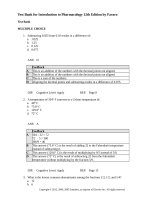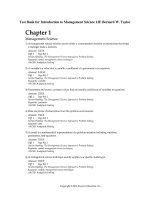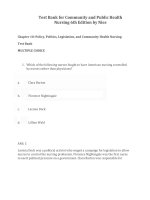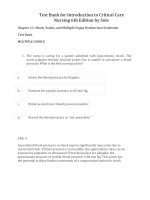Test bank for introduction to medical surgical nursing 5th edition linton
Bạn đang xem bản rút gọn của tài liệu. Xem và tải ngay bản đầy đủ của tài liệu tại đây (66.56 KB, 11 trang )
buy this full document at
Linton: Introduction to Medical-Surgical Nursing, 5th Edition
Chapter 01: The Health Care System
Test Bank
MULTIPLE CHOICE
1. An 89-year-old man, who was recently discharged from a rehabilitation hospital because of an
inability to concentrate and frequent memory lapses, cannot be left alone while his family works.
What options can the discharge planning team suggest that will satisfy safety concerns and give
the greatest quality of life to the patient?
a. Placement in a day care center from 8 AM to 5 PM daily
b. Placement in a long-term psychiatric facility
c. Placement in a high-security nursing home
d. Admission to a general hospital for evaluation
ANS: A
Day care centers provide supervision, safety, nutritious meals, and socialization while the caregiving family works.
DIF: Cognitive Level: Application
REF: p. 10
OBJ: 4
TOP: Day Care Centers
KEY: Nursing Process Step: Planning
MSC: NCLEX: Physiological Integrity: Reduction of risk
2. A 66-year-old hospitalized patient is anxious about how the physician will be paid now that he is
on Medicare−Parts A and B, instead of his previous privately funded insurance plan. The nurse
explains that the physician will be paid by:
a. Previous privately funded insurance plan
b. Medicare Part A
c. Medicare Part B
d. Patient or patient’s family
ANS: C
Part A pays skilled care facilities. Part B pays for physician’s services. The previously held
insurance is no longer available because of the patient’s age. The family or patient is not
responsible, because Part B is in effect.
DIF: Cognitive Level: Comprehension REF: p. 5
OBJ: 3
TOP: Health Care Funding
KEY:
Nursing Process Step:
Implementation
MSC: NCLEX: Safe Effective Care Environment: Coordinated care
buy this full document at
Full file at />3. A nurse could best refer an unemployed 42-year-old patient with renal failure who has lost his
job-related private insurance to which health care plan for his medical care?
a. Medicare
b. Medicaid
c. Public health facility
d. Community-based outpatient clinic
ANS: B
Medicaid is available to needy low-income persons under 65 years of age who have a permanent
disability. Medicare is for persons 65 years and older. Public health services are involved with
prevention more often than with chronic care.
DIF: Cognitive Level: Comprehension REF: p. 5
OBJ: 3
TOP: Health Care Funding
KEY:
Nursing Process Step:
Implementation
MSC: "NCLEX: Safe, Effective Care Environment: Coordinated care"
4. A 50-year-old woman with terminal lung cancer with extensive metastasis is requesting a hospice
transfer. The requirements for this transfer include which criteria?
a. Patient requests and agrees to the guidelines of hospice care without requiring a
physician’s order.
b. Physician confirms that the patient has 6 months or less of life remaining and has
provided a written order for hospice care.
c. Proof confirms that the family can no longer care for the patient at home.
d. Patient’s specific diagnosis is included on a list of accepted diseases that qualifies
the patient for hospice care.
ANS: B
The four criteria for transfer to hospice care are (1) diagnosis of any terminal illness, (2)
prognosis of less than 6 months of life, (3) informed consent of patient, and (4) written
physician’s order.
DIF: Cognitive Level: Comprehension REF: p. 10
OBJ: 4
TOP: Hospice Care
KEY: Nursing Process Step: Implementation
MSC: NCLEX: Physiological Integrity: Basic care and comfort
5. A 42-year-old patient admitted yesterday with a diagnosis-related group (DRG) diagnosis of
abdominal pain of an unknown cause is being discharged this afternoon because all diagnostic
tests have been negative. This scenario is an example of:
a. Effective laboratory response
b. Medicare guidelines limiting hospital stay
c. Cost containment related to a DRG diagnosis
d. Patient who should not have been admitted in the first place
ANS: C
Copyright © 2012, 2007, 2003, 2000, 1995 by Saunders, an imprint of Elsevier Inc.
Full file at />Cost containment is a means by which the cost of hospitalization time is reduced when the need
for acute hospital care is no longer necessary.
DIF: Cognitive Level: Comprehension REF: p. 5
OBJ: 5
TOP: Cost Containment per DRGs
KEY: Nursing Process Step: N/A
MSC: NCLEX: N/A
6. In discussing the discharge to a transitional subacute facility with a 72-year-old patient with
diabetes who has had both legs amputated, the nurse informs the patient that his stay in the new
facility will be limited to:
a. 25 days
b. 50 days
c. 75 days
d. Is totally unlimited
ANS: D
Medicare limitations are waived for patients who have undergone amputations.
DIF: Cognitive Level: Application
REF: p. 11
OBJ: 4
TOP: Stay in a Skilled Care Facility
KEY: Nursing Process Step: Planning
MSC: "NCLEX: Safe, Effective Care Environment: Coordinated care"
7. The nurse clarifies to the patient who is applying for Medicaid that the receipt of benefits
requires:
a. Following a supervised health maintenance plan
b. Enrolling in the Medicare-Preferred Drug Plan
c. Qualifying for the food stamp program
d. Having an annual income of less than $10,000
ANS: B
The Medicare-Preferred Drug Plan is a condition of Medicaid eligibility. Nonenrollment may
cause the loss of all health care benefits.
DIF: Cognitive Level: Application
REF: p. 2
OBJ: 3
TOP: Medicare-Preferred Drug Plan
KEY: Nursing Process Step: Implementation
MSC: NCLEX: Health Promotion and Maintenance: Coordinated care
8. Which is true concerning proprietary agencies?
a. They are organized to be nonprofit operations.
b. They are organized to make a profit on their operation.
c. Any profit they make is immediately used to purchase better equipment and
services.
d. They must participate in Medicare.
ANS: B
Copyright © 2012, 2007, 2003, 2000, 1995 by Saunders, an imprint of Elsevier Inc.
Full file at />These agencies are usually owned by large corporations and established for the purpose of
making a profit. Although most such agencies do participate in Medicare, it is not required.
DIF: Cognitive Level: Comprehension REF: p. 8
TOP: Proprietary Agencies
KEY:
MSC: NCLEX: N/A
OBJ: 4
Nursing Process Step: N/A
9. Which patient would the nurse recognize as eligible for a referral to Medicaid?
a. Military automobile mechanic with severe asthma
b. Pregnant unmarried young woman employed at a discount retail store for 3 years
c. College student on scholarship who works part-time at the college library and who
needs medication for arthritis
d. Unemployed young mother on welfare who needs diabetic medication for one of
her children
ANS: D
Medicaid covers medication and health care services for welfare recipients for child health and
long-term care.
DIF: Cognitive Level: Application
REF: p. 4
OBJ: 3
TOP: Medicaid Services Eligibility
KEY: Nursing Process Step: Planning
MSC: NCLEX: Health Promotion and Maintenance: Coordinated care
10. The Balanced Budget Act of 1997 was the cause of closures of many proprietary home health
care agencies because the Act:
a. Specified that all care be given by registered nurses (RNs).
b. Listed specific diagnoses that could qualify a patient for home health care.
c. Limited the amount of money that could be spent on a patient.
d. Increased the criteria for patient eligibility for home care.
ANS: C
The Balanced Budget Act of 1997 placed a limit on the amount of money that could be spent on
a patient’s home health care, regardless of diagnosis or needs.
DIF: Cognitive Level: Comprehension REF: p. 8
OBJ: 5
TOP: Balanced Budget Act of 1997
KEY: Nursing Process Step: N/A
MSC: NCLEX: N/A
11. The person who is considered the forerunner of modern public health nursing in the United
States is:
a. Vincent DePaul
b. William Rathbone
c. Florence Nightingale
d. Lillian Wald
ANS: D
Copyright © 2012, 2007, 2003, 2000, 1995 by Saunders, an imprint of Elsevier Inc.
Full file at />Lillian Wald is recognized as the forerunner of modern public health nursing.
DIF: Cognitive Level: Knowledge
REF: p. 7
TOP: Leaders and Founders of Public Health Nursing
MSC: NCLEX: N/A
OBJ: 1
KEY: Nursing Process Step: N/A
12. A voluntary health care agency is one that:
a. Is supported by tax dollars.
b. Is governed by boards made up of community members.
c. Receives no fee for its services.
d. Uses volunteers as health care providers.
ANS: B
Voluntary agencies are governed by boards made up of community members and are supported
by a variety of sources. They are not supported by tax dollars.
DIF: Cognitive Level: Comprehension REF: p. 8
OBJ: 3
TOP: Voluntary agencies
KEY: Nursing Process Step: N/A
MSC: NCLEX: Health Promotion and Maintenance: Coordinated care
13. A 76-year-old man, who is hospitalized for treatment after a stroke, asks the nurse how long he
can expect Medicare to cover his treatment. The nurse’s most informative response is:
a. “Your Part B will cover your hospital care as long as is necessary.”
b. “Your health care provider will determine how long your Medicare coverage will
be in effect.”
c. “You are allowed 50 days of inpatient care annually.”
d. “You can receive skilled care for up to 100 days.”
ANS: D
Persons hospitalized for skilled nursing care receive 100 days of Medicare coverage.
DIF: Cognitive Level: Application
REF: p. 4
OBJ: 4
TOP: Skilled Care Limitation
KEY: Nursing Process Step: Implementation
MSC: NCLEX: Health Promotion and Maintenance: Coordinated care
14. The nurse clarifies that health care benefits supported by both federal and state funding are
exemplified in:
a. Cost-containment prospective funding
b. Department of Health and Human Services (DHHS) Social Security benefits for
dentures
c. Centers for Disease Control and Prevention (CDC) surveillance of persons at risk
for acquired immunodeficiency syndrome (AIDS)
d. Medicaid provision for skilled care in the home
ANS: D
Federal and state cooperation are involved in home skilled care issues.
Copyright © 2012, 2007, 2003, 2000, 1995 by Saunders, an imprint of Elsevier Inc.
Full file at />DIF: Cognitive Level: Application
REF: p. 7
OBJ: 3
TOP: Coordinating Medicaid/Medicare Benefits
KEY: Nursing Process Step: Implementation
MSC: NCLEX: Health Promotion and Maintenance: Coordinated care
15. The nurse assessing a 65-year-old patient who is scheduled for outpatient surgery for the removal
of cataracts in 10 days will stress the need to:
a. Have adequate insurance
b. Provide adequate postoperative care at home
c. Acquire specialized glasses
d. Preserve and protect his vision
ANS: B
Outpatient surgical patients are at great risk for postoperative complications in the absence of
professional monitoring. This risk emphasizes the need for preoperative teaching and the
provision of postoperative support in the home.
DIF: Cognitive Level: Analysis
REF: p. 7
OBJ: 4
TOP: Postoperative Care for Outpatients
KEY:
Nursing Process Step: Assessment
MSC: NCLEX: Health Promotion and Maintenance: Coordinated care
16. The nurse explains that skilled nursing facilities are mandated to staff their facility with:
a. Licensed health professionals around the clock
b. RN in charge on each shift
c. RNs to supervise the patient care given by aides
d. Only RNs to provide complex care
ANS: A
A skilled facility must have licensed health care professionals around the clock. Licensed
practical nurses (LPNs) may supervise nursing assistants (NAs) who are the major caregivers.
LPNs can provide wound care, ostomy care, and monitor intravenous (IV) therapies.
DIF: Cognitive Level: Application
REF: p. 12
OBJ: 4
TOP: Skilled Nursing Facilities Staffing Requirements
KEY: Nursing Process Step: Implementation
MSC: "NCLEX: Safe, Effective Care Environment: Coordinated care"
17. The purpose of a long-term care facility is to:
a. Rehabilitate patients to their former level of functioning.
b. Restore patients to their optimal level of independence.
c. Offer care to patients who do not need hospitalization but cannot care for
themselves.
d. Exclusively care for patients with dementia.
ANS: C
Copyright © 2012, 2007, 2003, 2000, 1995 by Saunders, an imprint of Elsevier Inc.
Full file at />Long-term care facilities care for patients who do not need to be hospitalized but who cannot
care for themselves. Although many patients with dementia are residents in a long-term care
facility, the purpose of such facilities is not to provide their care exclusively.
DIF: Cognitive Level: Comprehension REF: p. 11
OBJ: 4
TOP: Long-Term Care Facilities
KEY: Nursing Process Step: N/A
MSC: "NCLEX: Safe, Effective Care Environment: Coordinated care"
18. A resident in a long-term care facility has difficulty swallowing and frequently chokes on food
and liquids. Because of the threat of aspiration, the nurse initiates a referral for a swallowing
evaluation to a:
a. Physician who specializes in throat disorders
b. Dietitian
c. Nutritionist
d. Speech therapist
ANS: D
Speech therapists are qualified to evaluate swallowing disorders.
DIF: Cognitive Level: Application
REF: p. 8
OBJ: 4
TOP: Swallowing Difficulties
KEY: Nursing Process Step: Implementation
MSC: NCLEX: Physiological Integrity: Coordinated care
19. A 2003 report from the Institute of Medicine (IOM), “Health Professions Education: A Bridge to
Quality,” outlined:
a. Specific software technology to increase efficiency in health care
b. Evaluation tool to evaluate the quality of health care
c. Recommendations for curriculum changes in professional health care schools
d. Five core competencies for health care professionals
ANS: D
The 2003 IOM report, “Health Professions Education: A Bridge to Quality,” stressed the need for
health professionals to be proficient in five areas: (1) providing patient-centered care, (2)
working as a member of a team, (3) using evidence-based medicine, (4) focusing on quality
improvement, and (5) using information technology.
DIF: Cognitive Level: Analysis
REF: p. 13
TOP: IOM report KEY: Nursing Process Step: N/A
OBJ: 8
MSC: NCLEX: N/A
MULTIPLE RESPONSE
1. The nurse clarifies the difference between a health maintenance organization (HMO) and a feefor-service plan by pointing out that an HMO: (Select all that apply.)
a. Requires a set fee from each client.
b. Allows clients to select their own health care provider.
Copyright © 2012, 2007, 2003, 2000, 1995 by Saunders, an imprint of Elsevier Inc.
Full file at />c. Permits admission to any inpatient facility.
d. Offers limited referral options.
e. Provides both inpatient and outpatient care.
ANS: A, E
HMOs require a set fee from each client to use health care providers specified or hired by each
HMO. Inpatient and outpatient care are provided in specified facilities. HMOs have a large group
of specialists to whom it refers clients. Fee-for-service plans are more expensive, but they allow
clients to choose the health care provider and facility.
DIF: Cognitive Level: Analysis
REF: p. 6
OBJ: 4
TOP: Comparison of HMO to Fee-for-Service
KEY: Nursing Process Step: Implementation
MSC: NCLEX: Health Promotion and Maintenance: Coordinated care
2. The nurse assures the parents of a newborn with a congenital heart defect that the home care for
their child is eased and supported by: (Select all that apply.)
a. Availability of smaller and more compact equipment
b. Specialized DRGs for home care of children
c. Medicaid-funded home care services
d. Home care services funded by private insurance
e. Grants and stipends from various drug manufacturers
ANS: A, B, C, D
Medicaid funds home care for children. Specialized DRGs and home-sized equipment make
home care for children more easily accomplished.
DIF: Cognitive Level: Analysis
REF: pp. 9, 10
OBJ: 4
TOP: Home Health Care for Children KEY: Nursing Process Step: Planning
MSC: NCLEX: Health Promotion and Maintenance: Coordinated care
3. The nurse outlines the benefits of using a home health aide for the ability to assist a home-bound
patient with: (Select all that apply.)
a. Bathing
b. Doing laundry
c. Shopping for groceries
d. Administering medications
e. Ambulating
ANS: A, E
Home health aides may assist with bathing, ambulation, skin care, and minor homemaking
chores. They are not qualified to administer medications. Tasks of laundry, heavy house cleaning,
and grocery shopping are inappropriate for the home health aide and are more appropriately
assigned to a homemaker serviceperson.
DIF: Cognitive Level: Analysis
REF: p. 9
OBJ: 4
Copyright © 2012, 2007, 2003, 2000, 1995 by Saunders, an imprint of Elsevier Inc.
Full file at />TOP: Home Health Aid Utilization
KEY: Nursing Process Step: Planning
MSC: NCLEX: Health Promotion and Maintenance: Coordinated care
4. When the patient inquires about eligibility for home health care, the nurse states that the criteria
for skilled home health care are: (Select all that apply.)
a. Annual income less than $20,000
b. Need for physical or speech therapy
c. Nonavailability of transportation
d. Must be homebound
e. Need for wound dressing changes
ANS: B, D, E
Eligibility for skilled care from a home health care aide include the need for nursing care for IV
therapies, respirators, wound dressing changes, and physical or speech therapy. No requirement
relative to low income or the lack of transportation exists, but the patient must be homebound.
DIF: Cognitive Level: Analysis
REF: p. 10
OBJ: 4
TOP: Home Health Care
KEY: Nursing Process Step: Planning
MSC: NCLEX: Physiological Integrity: Basic care and comfort
5. The nurse explains that the mission of the Public Health Service (PHS) is to: (Select all that
apply.)
a. Ensure safety of foods and cosmetics.
b. Provide access to health care services for low-income individuals.
c. Support medical research.
d. Support substance abuse prevention and treatment.
e. Monitor and prevent disease outbreaks.
ANS: A, B, C, D, E
The PHS focus is on all levels of ensuring community health, both in providing treatment and
supporting prevention. The PHS also supports medical research.
DIF: Cognitive Level: Analysis
REF: p. 2
OBJ: 2
TOP: Public Health Service
KEY:
Nursing Process Step:
Implementation
MSC: NCLEX: Health Promotion and Maintenance: Prevention and early detection of disease
6. The nurse explains that the Medicare Prescription Drug Plan will: (Select all that apply.)
a. Be included in Medicare, Part A.
b. Charge a $250 deductible.
c. Pay approximately 25% of prescription drug expenses.
d. Cover only prescriptions written by a medical physician.
e. Reimburse 95% of out-of-pocket expenses over $3600.
Copyright © 2012, 2007, 2003, 2000, 1995 by Saunders, an imprint of Elsevier Inc.
Full file at />ANS: B, E
Medicare Prescription Plan (Medicare Part D) requires a separate enrollment, pays 50% of drug
expenses after the $250 deductible is satisfied, honors all prescriptions written by licensed
medical personnel who have prescriptive power, and covers 95% of out-of-pocket expenses up to
$3600.
DIF: Cognitive Level: Application
REF: p. 5
OBJ: 3
TOP: Medicare Prescription Plan
KEY: Nursing Process Step: Implementation
MSC: "NCLEX: Safe, Effective Care Environment: Coordinated care"
7. The nurse explains that physicians prefer to use e-prescription systems to: (Select all that apply.)
a. Process drug request more efficiently.
b. Prevent drug duplications.
c. Use less expensive drugs.
d. Identify contraindications for a drug.
e. Label both the generic and trade names.
ANS: A, B, D
E-prescription systems that expedite the request also generate drug information related to
contraindications and side effects and can identify duplication of drugs.
DIF: Cognitive Level: Analysis
REF: p. 12
TOP: Topic: e-prescriptions
KEY:
Implementation
MSC: NCLEX: Physiological Integrity: Reduction of risk
OBJ: 7
Nursing Process Step:
8. The DHHS is administered by: (select all that apply)
a. PHS
b. Administration for Children and Families
c. Administration on Aging
d. American Medical Association
e. Centers for Medicare and Medicaid
ANS: A, B, C, E
The PHS, Administration for Children and Families, Administration on Aging, and Centers for
Medicare and Medicaid all share the administration of the DHHS.
DIF: Cognitive Level: Comprehension REF: p. 2
TOP: DHHS
KEY: Nursing Process Step: N/A
OBJ: 4
MSC: NCLEX: N/A
COMPLETION
1. The nurse clarifies that the insurance plan that pays the physician in advance each month for
each enrolled patient, whether or not the patient is treated by the physician, is a strategy known
as ____________________.
ANS:
Capitation
Copyright © 2012, 2007, 2003, 2000, 1995 by Saunders, an imprint of Elsevier Inc.
Full file at />Capitation is the system of payment that collects monthly “fees” from enrollees and pays the
physician whether the patient has been treated or not. It is rather like a salary that assures the
attention of a physician in the event of an illness
DIF: Cognitive Level: Analysis
REF: p. 4
OBJ: 4
TOP: Capitation KEY: Nursing Process Step: Implementation
MSC: NCLEX: Safe, Effective Care Environment
Copyright © 2012, 2007, 2003, 2000, 1995 by Saunders, an imprint of Elsevier Inc.









